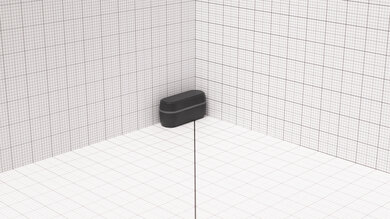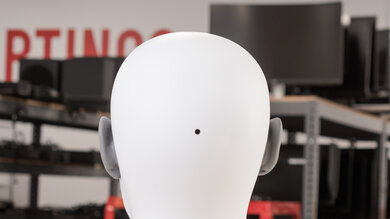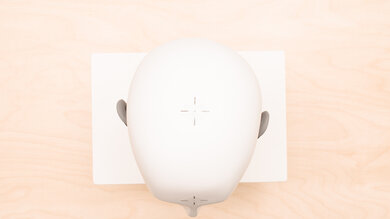The Skullcandy Jib True Wireless are basic truly wireless in-ears. They offer a bass-heavy but otherwise well-balanced sound profile, good passive noise isolation capability, and a sturdy-feeling design. Unfortunately, they don't have the most stable fit, and their microphone struggles with isolating speech from background noise. They also have high wireless latency, though this may not present a huge problem if you don't plan on watching a lot of movies or gaming while wearing them.
Our Verdict
The Skullcandy Jib True are okay for neutral sound. Fans of EDM and hip-hop may enjoy their bass-heavy sound profile, but it can muddy mixes. Thankfully, their mid and treble range are mostly well-balanced overall, yielding present, clear, and detailed vocals and lead instruments. While their in-ear fit allows them to deliver audio very consistently, they have an exceptionally small soundstage, even by the standards of other closed-back truly wireless headphones.
- Exceptionally consistent audio delivery.
- Well-balanced mid and treble response.
- No sound customization features.
- Very closed-off soundstage.
The Skullcandy Jib True Wireless are good for commuting and travel. They're remarkably portable and feel sturdy enough to survive a couple of drops and bumps. They should do a good job of filtering out the chatter of fellow commuters, but some bass-range noise, like the rumble of a bus engine, may interfere with your listening experience. While they don't have enough continuous battery life to last an entire overnight flight, you can listen to one bud while the other recharges in its case.
- Very good passive noise isolation.
- Solid-feeling build quality.
- Portable, lightweight design.
- 6.1-hour continuous battery life is a little short.
The Skullcandy Jib True Wireless are a great option for sports and fitness. They feel solidly built and are certified IPX4 for water resistance against splashes in all directions. Their physical control scheme puts a fair bit of functionality at your fingertips, but it may take some time to get used to them. Since they lack stability fins and have bulky outer casings, they aren't the most stable option for high-intensity workouts.
- Solid-feeling build quality.
- Portable, lightweight design.
- Fit isn't stable enough for high-intensity workouts.
The Skullcandy Jib True are satisfactory for office use. They leak almost no audio, so you can listen to your music at high volumes without disrupting coworkers. They also do an amazing job of filtering out mid and treble-range background noise, like the chatter of noisy coworkers or the hum of an overhead AC unit. That said, they don't support conveniences like multi-device pairing, which may be annoying if you like to switch between listening to content on your phone and computer.
- Very good passive noise isolation.
- Superb audio leakage performance.
- Relatively high wireless latency.
- 6.1-hour continuous battery life is a little short.
The Skullcandy Jib True aren't suitable for wireless gaming due to their incompatibility with PS4 and Xbox One consoles and relatively high audio latency on PC.
The Skullcandy Jib True are truly wireless headphones that aren't compatible with wired connections.
The Skullcandy Jib True are passable for phone calls. Their integrated mic makes your voice sound natural, clear, and mostly free of distortion, but also somewhat thin. The mic also struggles to isolate speech from moderately loud background noise, so people on the other end of the line can have a lot of trouble understanding you if you call from a subway station or even a busy street. However, the buds themselves do a very good job of blocking out background noise, so you can stay focused on what's being said on a call.
- Very good passive noise isolation.
- Sub-par microphone noise handling capability.
Changelog
- Updated Oct 21, 2021: Converted to Test Bench 1.5.
- Updated Sep 22, 2021: Updated review for accuracy and clarity.
- Updated Oct 15, 2020: Review published.
- Updated Oct 07, 2020: Early access published.
Check Price
Differences Between Sizes And Variants
The Skullcandy Jib True Wireless come in several different color variants: 'True Black', 'Chill Grey', 'Orange/Black', 'Golden Age Red', 'Light Grey/Blue', and '92 Blue', which is red, blue, and yellow. We tested the 'True Black' variant, and you can see its label here. We expect the other color variants to perform similarly overall.
If someone comes across a variant that's different from those listed above, let us know in the discussions so that we can update our review.
Popular Headphones Comparisons
The Skullcandy Jib True Wireless are simple truly-wireless in-ears. They have a solid-feeling plastic construction, very good passive noise isolation capability, and a bass-heavy sound profile that should please EDM and hip-hop listeners, though it may not be to everyone's liking. They aren't especially stable in the ear, can be a little uncomfortable for some, and have high wireless latency, especially on PC and Android devices.
If you're looking for more options, take a look at our list of recommendations of the best wireless Bluetooth earbuds under $50, the best earbuds for bass, and the best true wireless earbuds.
The JLab Audio GO Air POP True Wireless are better for most purposes than the Skullcandy Jib True Wireless. The JLab have a flatter sound profile, which some may prefer, a better microphone performance, and a longer continuous battery life. They also have a much more stable fit and a few built-in EQ presets. On the other hand, the Skullcandy have a significantly better passive noise isolation performance.
Despite their similar names, the Skullcandy Jib Wireless and Skullcandy Jib True Wireless are very differently designed headphones each with their strengths. The Jib have an in-line microphone with better noise-handling capability and noticeably lower wireless latency on iOS and Android devices. However, the Jib True are better built, block out more ambient noise, leak less audio, and last longer on a single charge. They're also more portable courtesy of their truly wireless design.
The JBL Vibe 100TWS True Wireless are somewhat better in-ears than the Skullcandy Jib True Wireless. While both headphones are comfortable and well-built, the JBL have a more neutral sound profile, which some users may prefer, and their integrated mic offers better overall performance. However, the Skullcandy can block out background noise and have a longer continuous battery life.
The FIIL T1X True Wireless are better overall truly wireless in-ears than the Skullcandy Jib True Wireless. The FIIL have a comfier, more stable fit, a slightly better-balanced sound profile, a microphone with superior noise-handling capability, and a longer battery life. They also have more features, like a companion app granting you access to 15 different EQ presets. The Skullcandy block out more ambient noise, leak less audio, and have a microphone with better recording quality.
Test Results

The Skullcandy Jib True Wireless are compact truly wireless in-ears. They have a similar design to the Skullcandy Sesh Truly Wireless and don't stick out from your ears too much. Although we tested the 'True Black' color, they come in several other color variations to fit your style, including '92 Blue', which is made of blue plastic with yellow highlights and red ear tips.
The Skullcandy Jib True Wireless are decently comfortable. They're lightweight, don't enter your ear canal too deeply, and don't apply too much pressure. However, the outer buds are a little bulky, and using their control scheme does force their tips deeper into your ear.
The Skullcandy Jib True Wireless have an okay control scheme. There's a clicky physical button on each bud and you receive voice prompts when you're turning the headphones on/off and when you're in Bluetooth pairing mode. However, the controls aren't the most intuitive, and it can take some time to get used to.
On either earbud:
- One press: Plays or pauses audio. Also answers and ends calls.
- Triple press: Activates voice assistant.
- Press and hold for two seconds: Powers the headphones on.
- Press and hold for four seconds: Turns the headphones off.
On the left earbud:
- Double press: Lowers the volume.
- Press and hold for two seconds: Skips the track backward.
On the right earbud:
- Double press: Raises the volume.
- Press and hold for two seconds: Skips the track forward.
Using both earbuds:
- Press and hold for ten seconds when the headphones are off: Resets the headphones.
Like most truly wireless headphones, the Skullcandy Jib True Wireless are exceptionally portable. You can easily store the buds in your pockets or a bag. The same can be said for their charging case, which is also very small.
The Skullcandy Jib True Wireless have a good charging case. It's compact and made of hard plastic, so it should protect the buds from minor drops and bumps. The case also features a small indicator light to show current battery life. Unlike the JBL Vibe 100TWS True Wireless' carrying case, it also has a lid to help protect the headphones when you're on the go.
These headphones are well-built. They're made of solid-feeling plastic and should survive a couple of minor drops and bumps. Just like the Skullcandy Dime True Wireless, the buds are certified IPX4 for water resistance from splashes in all directions.
The Skullcandy Jib True Wireless have a decently stable fit. They're not the best option for high-intensity workouts since they lack stability fins and move around even with low-intensity head movements. Consider the Mpow MDots True Wireless or the Skullcandy Spoke True Wireless if you're looking for in-ears with a more stable fit.
These in-ears have a very bass-heavy sound profile. Their overemphasized bass response adds extra thump and rumble to your favorite EDM and hip-hop tracks, but it also slightly muddies some vocals and lead instruments. The rest of their frequency range is well-balanced, which should yield clear, present, and detailed vocals and lead instruments. On the downside, these headphones lack an EQ, which is disappointing if you want to customize their sound.
These in-ears have superb frequency response consistency. Once you achieve a tight seal with the included ear tips, you should get consistent audio delivery on separate occasions.
The Skullcandy Jib True Wireless' bass accuracy is passable. It's overemphasized across the range, so mixes have extra, thump, punch, and boom. However, this can sound muddy.
Their mid accuracy is great. While the overemphasized low-mids slightly muddy some vocals and lead instruments, the rest of the frequency range is quite well-balanced. Those same vocals and lead instruments should also sound present and clear in the mix.
The Skullcandy Jib True's treble accuracy is good. The range is mostly well-balanced, except for a slight dip in the mid-treble range resulting in sibilants losing a slight bit of brightness.
The peaks and dips performance is excellent. A peak that goes through the high-bass range and into the low-mids slightly muddies some vocals and lead instruments, while the following dip pushes those vocals and lead instruments toward the back of the mix. Another dip in the mid-treble range generates a slight loss of brightness in sibilants.
Their stereo imaging performance is satisfactory. Their weighted group delay falls entirely beneath the audibility threshold, resulting in tight bass and transparent treble. While the L/R drivers are well-matched in amplitude and frequency response, some phase mismatch is present. This impacts their ability to accurately place objects in the stereo image and generate an immersive listening experience. That said, these results are only valid for our unit, and yours may perform differently.
The Skullcandy Jib True Wireless' passive soundstage is awful. They have a closed-back enclosure and in-ear design that bypasses any interaction with the outer ear, which is crucial in generating an out-of-head listening experience. Sound is perceived as coming from the inside of your head rather than all around you.
The weighted harmonic distortion performance is great. There's very little distortion across the frequency range, resulting in clean and pure audio reproduction.
These are the settings used to test the Skullcandy Jib True Wireless. Our results are only valid when the headphones are set up this way.
Their noise isolation performance is very good. While these headphones lack an ANC feature and block out little bass-range ambient noise like bus engines and construction equipment, they do an outstanding job of passively dealing with background audio in the mid and treble ranges. You shouldn't hear too many sounds like chatter from people nearby or the hum of an AC unit.
The Skullcandy Jib True Wireless have a remarkable audio leakage performance. Virtually no audio should escape from your ear canal once you achieve an airtight fit with the included ear tips. You can probably listen to your music at very high volumes without disrupting people nearby.
The integrated mic's recording quality is okay. Your voice should sound natural, fairly clear, and be mostly free of distortion, but it may also be perceived as thin.
The Skullcandy Jib True Wireless' mic has sub-par noise handling. It has a hard time separating your voice from moderate ambient noise, so if you're taking a call from a loud environment like a busy street, your voice may be drowned out.
The Skullcandy Jib True deliver an unremarkable battery performance. They provide about six hours of continuous playback time on a single charge, less than other budget-friendly alternatives like the FIIL T1X True Wireless or the JLab Audio GO Air POP True Wireless, but this can vary with overall usage. Combined with the roughly three additional charges supplied by their case, they have a total battery life of over 22 hours, so they should last you a couple of days at work. You can use one of the buds while the other charges in its case, though you can't access volume and track skipping controls.
Update 10/22/2021: These headphones were updated to Test Bench 1.5 and their latency values have changed. Our previous Test Bench 1.4 measurements reported 'PC latency' at 258 ms, 'iOS latency' at 234 ms, and 'Android Latency' at 195 ms. However, our new test bench uses an average of three measurements instead of one, resulting in different values. As a result, we have updated our text to better reflect test bench 1.5 measurements.
These in-ears have okay Bluetooth connectivity. Unfortunately, they don't support NFC or multi-device pairing. They also have high latency on Android, and PC devices, so your audio and visuals may be out of sync with one another, which could be annoying if you like to stream video. Their latency on iOS devices is lower, but you still may experience slight audio lag. However, some apps and devices compensate for latency differently, so your real-world experience may vary.
The Skullcandy Jib True Wireless Earbuds have a charging case that supplies roughly 2.7 extra charges. You can recharge it via their USB-A to micro-USB cable. However, the case doesn't support wireless charging.















